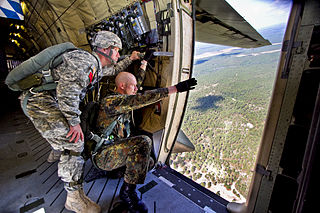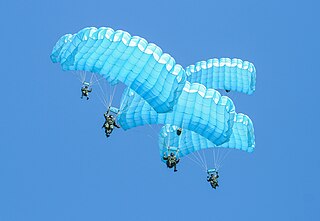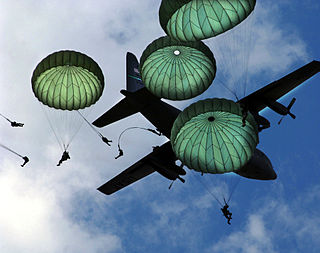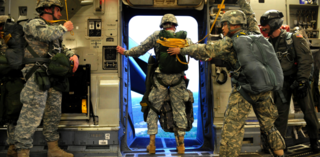
Parasailing, also known as parascending, paraskiing orparakiting, is a recreational kiting activity where a person is towed behind a vehicle while attached to a specially designed canopy wing that resembles a parachute, known as a parasail wing. The manned kite's moving anchor may be a car, truck, or boat. The harness attaches the occupant to the parasail, which is connected to the boat, or land vehicle, by the tow rope. The vehicle then drives off, carrying the parascender and person into the air. If the boat is powerful enough, two or three people can parasail behind it at the same time. The parascender has little or no control over the parachute. The activity is primarily a fun ride, not to be confused with the sport of paragliding.

A parachute is a device used to slow the motion of an object through an atmosphere by creating drag or, in a ram-air parachute, aerodynamic lift. A major application is to support people, for recreation or as a safety device for aviators, who can exit from an aircraft at height and descend safely to earth.

A paratrooper is a military parachutist—someone trained to parachute into a military operation, and usually functioning as part of airborne forces. Military parachutists (troops) and parachutes were first used on a large scale during World War II for troop distribution and transportation. Paratroopers are often used in surprise attacks, to seize strategic objectives such as airfields or bridges.

High-altitude military parachuting, or military free fall (MFF), is a method of delivering military personnel, military equipment, and other military supplies from a transport aircraft at a high altitude via free-fall parachute insertion. Two techniques are used: HALO and HAHO.

A parachutist badge is a military badge awarded by the armed forces of many states to soldiers who have received parachute training and completed the required number of jumps. It is difficult to assess which country was the first to introduce such an award.

The Military Freefall Parachutist Badge is a military badge of the United States Army and United States Air Force awarded to qualified U.S. Army and U.S. Air Force personnel as high-altitude military parachute specialists.

The Parachutist Badge, also commonly referred to as "Jump Wings", is a military badge of the United States Armed Forces. Some services, such as the Marine Corps, officially refer to it as an insignia instead of a badge. The United States Space Force and United States Coast Guard are the only branches that do not award the Parachutist Badge, but their members are authorized to receive the Parachutist Badges of other services in accordance with their prescribed requirements. The DoD military services are all awarded the same Military Parachutist Badge. The U.S. Army and U.S. Air Force issue the same Senior and Master Parachutist Badges while the U.S. Navy and U.S. Marine Corps issue the Navy and Marine Corps Parachutist Insignia to advanced parachutists. The majority of the services earn their Military Parachutist Badge through the U.S. Army Airborne School.

The United States Army Airborne School—widely known as Jump School—conducts the basic paratrooper training for the United States Armed Forces. It is operated by the 1st Battalion (Airborne), 507th Infantry, United States Army Infantry School, Fort Moore, Georgia. The Airborne School conducts the Basic Airborne Course, which is open to troops from all branches of the United States Department of Defense, Reserve Officer Training Corps, and allied military personnel.

A static line is a fixed cord attached to a large, stable object. It is used to open parachutes automatically for paratroopers and novice parachutists.
A parachute rigger is a person who is trained or licensed to pack, maintain or repair parachutes. A rigger is required to understand fabrics, hardware, webbing, regulations, sewing, packing, and other aspects related to the building, packing, repair, and maintenance of parachutes.

The Denison smock was a coverall jacket issued to Special Operations Executive (SOE) agents, the Parachute Regiment, the Glider Pilot Regiment, Air Landing Regiments, air observation post squadrons, Commando units, and other Commonwealth airborne units, to wear over their Battle Dress uniform during the Second World War. The garment was also issued as standard to the scout and sniper platoons of line infantry battalions.

The United States Army Parachute Team, nicknamed the Golden Knights, is a demonstration and competition parachute team of the United States Army. It consists of demonstration and competition parachutist teams, drawn from all branches of the U.S. Army. Members must demonstrate excellence in parachuting.

Jumpmasters are the expert paratroopers in an airborne unit who train and teach the military techniques for jumping from airplanes. They are responsible for training soldiers who enter Army Airborne School into paratroopers and managing airborne jump operations in airborne units across all branches of services.
The Basic Parachute Course for members of the British Armed Forces is conducted by the Parachute Training Squadron of the Airborne Delivery Wing, based at RAF Brize Norton.

Parachuting and skydiving is a method of transiting from a high point in an atmosphere to the ground or ocean surface with the aid of gravity, involving the control of speed during the descent using a parachute or parachutes.

The T-10 Parachute is a series of static line-deployed parachutes used by the militaries for combat mass-assault airborne operations and training. The T-10 parachute was introduced in the early 1950s. In 1976, the B model introduced the anti-inversion net; in 1986, the C model was introduced, which changed the pocket band free length from 4" to 7½". The T-10D, adopted in 2000, includes the detachable pack tray, which in itself includes the 15' universal static line and 5' extension static line. The T-10D is currently being replaced by the T-11 parachute system. In 2006, all T-10C parachutes were revised by adding one static line stow bar to each side of the pack tray; the material for the T-10C was also changed to the muddy water 407.

The Non-Maneuverable Canopy (T-11) Personnel Parachute System is the newest personnel parachute system to be adopted by the United States armed forces and the Canadian Army. The T-11 replaces the T-10, introduced in 1955. The T-11 includes a completely redesigned main and reserve parachute and an integrated harness assembly that is suitable for a wider range of soldier weights than the previous system.

The RA-1 Military Free-Fall Advanced Ram-Air Parachute System provides a multi-mission, high-altitude parachute delivery system that allows personnel to exit at altitudes between 3,500 feet and 35,000 feet. The parachute, which replaces the current MC-4 parachute, supports a total jumper weight of 450 pounds. It also provides non-MFF personnel with a ram-air parachute that is static-line deployed.

The United States Army Jumpmaster School trains personnel in the skills necessary to jumpmaster a combat-equipped jump and the proper attaching, jumping, and releasing of combat and individual equipment while participating in an actual jump that is proficient in the duties and responsibilities of the Jumpmaster and Safety; procedures for rigging individual equipment containers and door bundles; personnel parachute components by their specific nomenclature and characteristics; procedures and standards required to conduct a JumpMaster Personnel Inspection (JMPI); the duties and responsibilities of the Drop Zone Safety Officer; the presentation of the Jumpmaster briefing and sustained airborne training (SAT); and the execution of the duties of a Jumpmaster and Safety from a USAF aircraft during a day/night combat equipment jump.

Aircrew survival equipmentmen are survival equipment specialists and certified parachute riggers who oversee valuable life saving equipment, parachutes, and other special gear used by U.S. Naval and Marine Corps special operations forces, Naval Air Department, and the United States Navy Parachute Team known as the "Leap Frogs". They perform a wide range of duties, which include inspecting, maintaining, and repairing parachutes, search and rescue equipment, along with survival kits, medical kits, flight clothing, protective wear, night vision equipment, aircrew oxygen systems, liquid oxygen converters, anti-exposure suits, and g-suits. PRs operate and maintain carbon dioxide transfer and recharge equipment, operate and repair sewing machines as well as train aircrew and other personnel in parachute rigging and the use of safety and survival equipment.



















